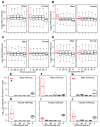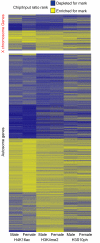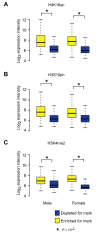An evolutionary consequence of dosage compensation on Drosophila melanogaster female X-chromatin structure?
- PMID: 20051121
- PMCID: PMC2820458
- DOI: 10.1186/1471-2164-11-6
An evolutionary consequence of dosage compensation on Drosophila melanogaster female X-chromatin structure?
Abstract
Background: X chromosomes are subject to dosage compensation in Drosophila males. Dosage compensation requires cis sequence features of the X chromosome that are present in both sexes by definition and trans acting factors that target chromatin modifying machinery to the X specifically in males. The evolution of this system could result in neutral X chromatin changes that will be apparent in females.
Results: We find that the general chromatin structure of female X chromosomes is distinct from autosomes. Additionally, specific histone marks associated with dosage compensation and active chromatin marks on the male X chromosome are also enriched on the X chromosomes of females, albeit to a lesser degree.
Conclusions: Our data indicate that X chromatin structure is fundamentally different from autosome structure in both sexes. We suggest that the differences between the X chromosomes and autosomes in females are a consequence of mechanisms that have evolved to ensure sufficient X chromosome expression in the soma of males.
Figures







References
-
- Lucchesi JC. Dosage compensation in Drosophila. Isozymes Curr Top Biol Med Res. 1983;9:179–188. - PubMed
Publication types
MeSH terms
Substances
Grants and funding
LinkOut - more resources
Full Text Sources
Molecular Biology Databases

